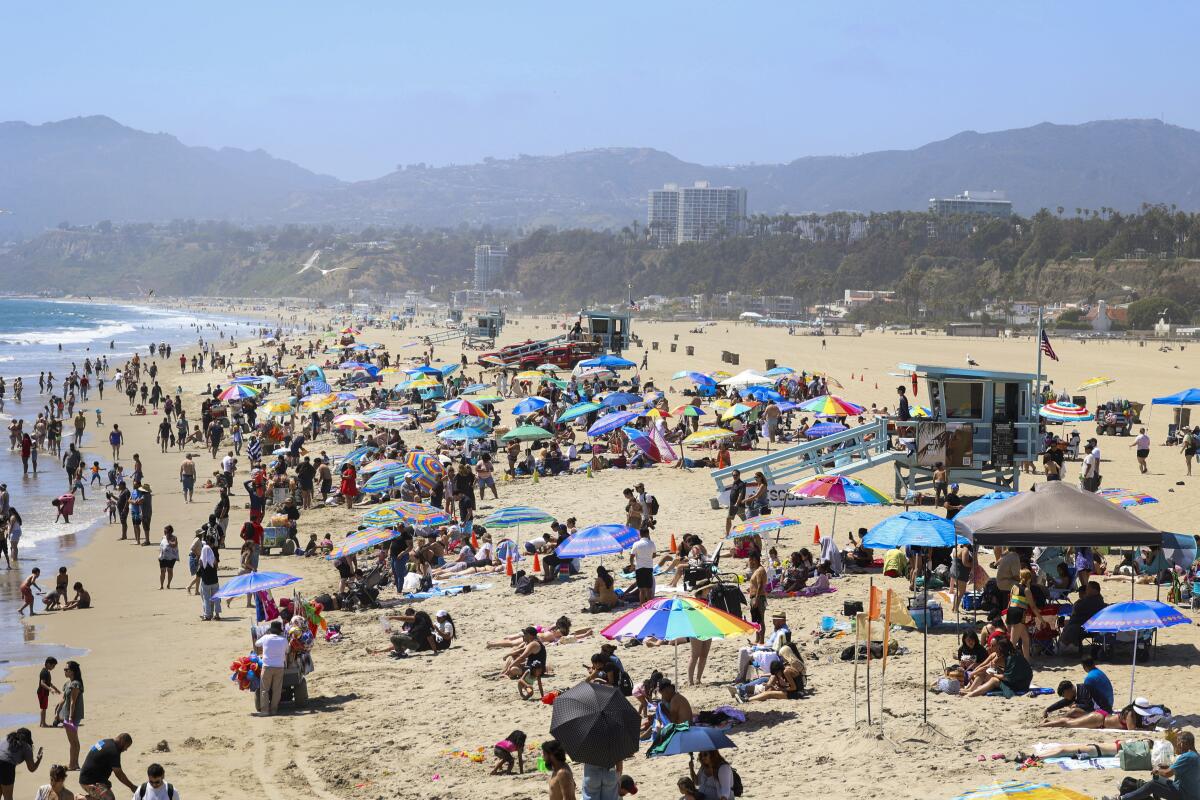Good morning, and welcome to the Essential California newsletter. It’s Saturday, June 29. Here’s what you need to know to start your weekend:
Don’t fall for these sunscreen myths
As we inch closer to July, summer heat is arriving at a rapid pace. No more cool breezes from our open windows, just constant heat throughout the day.
Warmer weather often leads us to spend more time cooling off at the beach or by the pool. But there’s something we have to watch out for as we spend more time outside: the sun’s UV rays.
As my colleague Karen Kaplan writes, “longer-wavelength ultraviolet A rays can reach beneath the skin’s surface, causing it to age prematurely. Shorter-wavelength ultraviolet B rays affect the outermost layers of skin, causing sunburns and tans.”
Both UVA and UVB damage the DNA in skin cells, causing mutations. These mutations can accumulate over time and cause tumors to grow. The more UV exposure you have, the greater the risk, according to the Skin Cancer Foundation.

Santa Monica Pier on June 25, 2024. (Zoe Cranfill / Los Angeles Times)
Melanoma of the skin is more rare and deadly, affecting an estimated 100,640 Americans this year and resulting in 8,290 deaths, according to the National Cancer Institute.
Protect your skin by using sunscreen, which can protect you from malignancies in two ways: chemical and mineral sunscreens. Chemical sunscreens contain ingredients that absorb UV rays while mineral sunscreens rely on zinc oxide or titanium dioxide to block or reflect the rays.
No matter what sunscreen you use, be sure to lather up before you head outdoors and don’t fall for these 10 sunscreen myths.
Here are just a few of the biggest sunscreen myths Karen highlights:
As long as you don’t get a sunburn, you’re safe
False! You don’t need to get a sunburn to put your skin at risk. UV exposure will compromise the DNA of unprotected skin — even if your skin looks normal to the naked eye — and the effects are cumulative, said Dr. Henry Lim, a photodermatologist at Henry Ford Health in Detroit who studies the effect of sunlight on skin.
“Each time the skin is damaged by the sun, with or without sunburn reaction, there is some damage that the skin would have to repair,” Lim told Karen. “If that subclinical damage goes on often enough for a long enough period of time, the skin’s ability to be able to completely repair all that DNA damage will be compromised.”
You don’t need sunscreen if you have dark skin
Absolutely you do! People of every complexion can get sun damage and skin cancer. In fact, “skin cancer in patients with darker skin tones is often diagnosed in later stages, when it’s more difficult to treat,” said Dr. Seemal Desai, president of the American Academy of Dermatology.
The chemicals in sunscreen can cause cancer
Wrong! The active ingredients in sunscreens sold in the U.S. are regulated by the Food and Drug Administration, which has determined that they are safe and effective. The National Academies add that “sunscreen use is not linked to higher rates of any type of cancer.”
You can keep sun damage at bay by wearing a good hat
Not exactly! A wide-brimmed hat can help protect you from the sun, particularly for people who are bald or have thinning hair.
However, Karen reports that a hat will only block UV rays coming from above. Without sunscreen, you’ll still be vulnerable to rays that reflect off the water, sand or urban surfaces like a sidewalk, which can reach your skin from below. (This is also why you need sunscreen even if you’re in the shade.)
Here’s more on sunscreen myths you can’t afford to fall for.
The week’s biggest stories

People watch the presidential debate between Donald Trump and Joe Biden at XR Studio in Los Angeles. (Gina Ferazzi/Los Angeles Times)
Presidential debate
California insurance crisis
Homelessness
More big stories
No comments:
Post a Comment